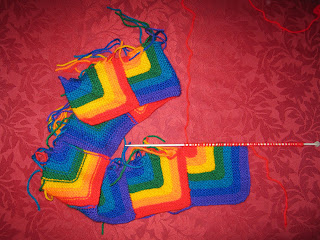I
recently discovered this amazing way of producing square motifs – it’s
variously known as modular knitting, domino knitting and mitred knitting. The basic instructions came from here, but you
will need to adjust the number of stitches depending on what size you want the
squares to be, and also how many colours you want to use.
In
keeping with my obsession with rainbow colours, so needing 7 coloured stripes,
I started with 42 stitches – this gives you 6 rows for each stripe. I decided to start with something simple – a
cushion cover – but you could just keep going and produce a large throw (known
as an Afghan in the US).
Each
new square is attached to the existing ones by picking up stitches, rather than
by sewing them all together afterwards – great if you hate sewing knitted
pieces together. The downside is all
the ends that have to be sewn in; I found it easier to do this last, as you can
then weave them into the seams so that they don’t show on the right side.
Note: I find the easiest
way to pick up stitches is to use a crochet hook, preferably a long one. Pick up all the stitches onto the hook, then
transfer them to the knitting needle from the wrong end of the hook. You may have to do the stitches in groups if
the hook is not long enough – there must be a device out there that is a
combination of knitting needle and crochet hook, but I haven’t found one yet!
Later note - February 2013 - I've found the mysterious device! Pack of 14 bamboo Afghan hooks in sizes from 3 mm to 10 mm from Amazon here
Later note - February 2013 - I've found the mysterious device! Pack of 14 bamboo Afghan hooks in sizes from 3 mm to 10 mm from Amazon here
Rainbow Cushion
Materials
Double knitting yarn in rainbow colours – mine were mainly Sirdar Hayfield Budget DK in red, orange, yellow, green, kingfisher, royal and purple - about 25 g of each colour.
Pair
3.75mm (UK 9, US 4) Knitting needles
3.75mm
crochet hook (for picking up stitches – see note above)
16 inch square
cushion pad
First square
With
purple, cast on 44 sts.
Wrong
side (WS): K2tog, K 40, K2tog (42 sts)
*Right
side (RS): K19, K2tog, s1, k1, psso, K19 (40 sts)
WS:
K 40
RS:
K18, K2tog, s1, k1, psso, K18 (38 sts)
 |
| First square with 1 st left to start next square |
WS:
K38
Change
to royal, and continuing to dec twice as above at the centre of each RS row,
work 6 rows.
Change
to kingfisher and work 6 rows as above.
Continue
to change colour every 6 rows, using green, yellow, orange then red.
Continue
until 4 sts remain.
RS:
K2tog, s1, k1, psso
WS:
K2tog. Do not fasten off, as you will
start the next square with red.
Squares 2 to 8
 |
| Ready to knit first row of square 2 |
With
the last st from the first square still on your needle, pick up a further 21
sts along the upper edge of your square.
Cast on a further 22 sts. (44 sts in all)
WS:
K2tog, K 40, K2tog (42 sts)
Continue
from * in the first square, reversing the colour sequence, i.e. after red, work
in orange, then yellow, green, kingfisher, royal and finally purple.
 |
| Ready to knit first row of square 9 |
Continue
to add squares in this manner until you have 8 squares in a line. Fasten off yarn after the 8th
square.
Square 9
Using
red, cast on 22 sts, then pick up 22 sts along right edge of square 1.
WS:
K2tog, K40, K2tog (42 sts)
Continue
from * in the first square, reversing the colour sequence, i.e. after red, work
in orange, then yellow, green, kingfisher, royal and finally purple.
Squares 10 to 16
 |
| Joining a square on 2 sides |
With
the last st from the square 9 still on your needle, pick up another 21 sts
along the upper edge of your square, then a further 22 sts along the right edge
of square 2.
WS:
K2tog, K 40, K2tog (42 sts)
Continue
from * in the first square.
Continue
to add squares in this manner until you have a second row of 8 squares.
Squares 17 to 32
Work
another 2 rows of squares as for Squares 10 to 16, alternating the colour
sequence as shown.
 |
| Numbering of squares |
Turn
cushion cover right side out and insert cushion pad – you will need one
approximately 16 inches square.

Love it!
ReplyDelete